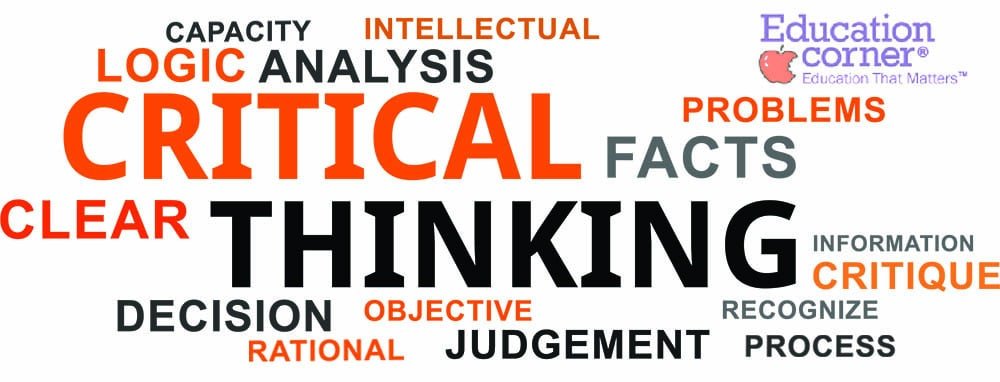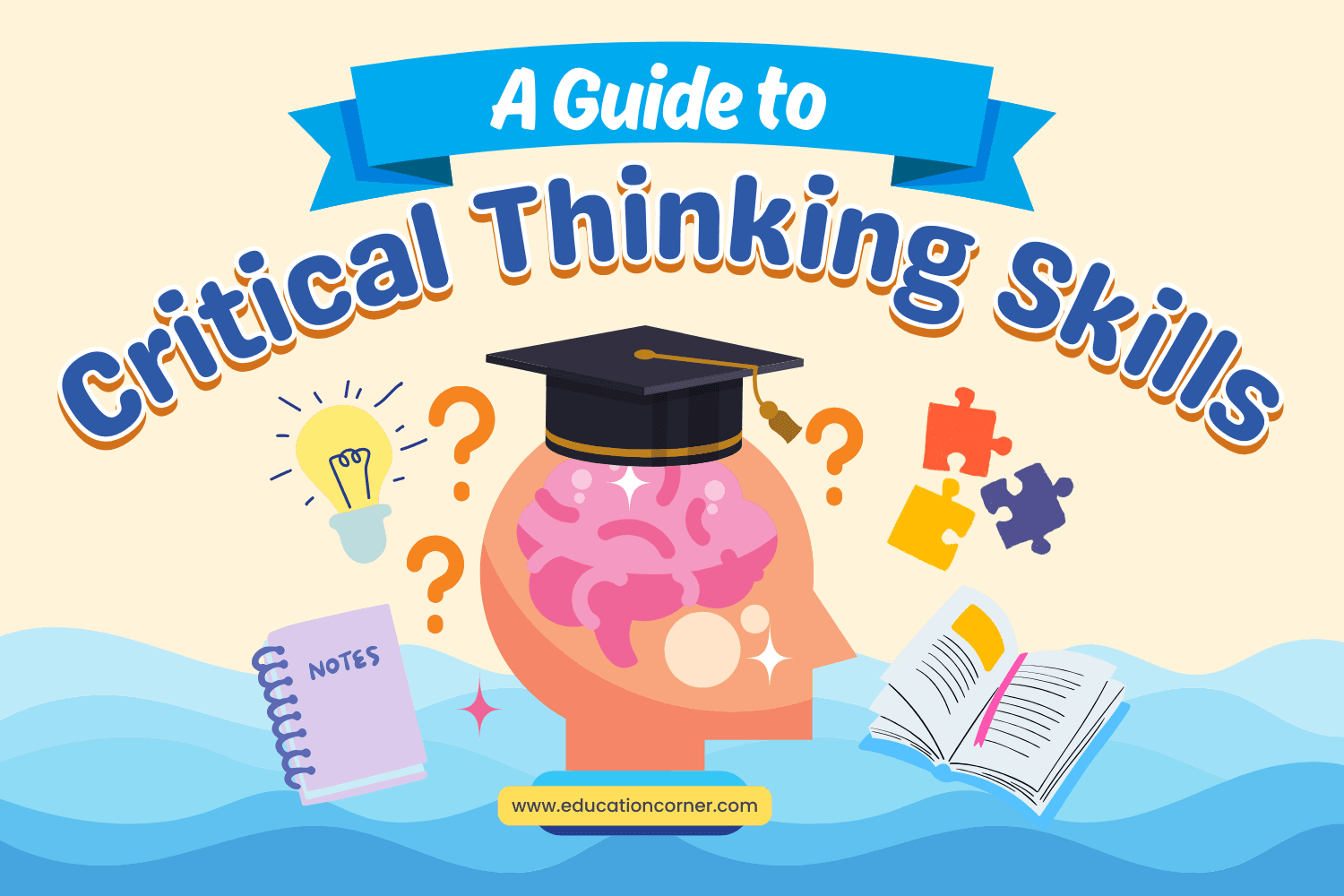Critical thinking is important. Generally speaking, critical thinking refers to the ability to understand the logical connections between ideas. When a person understands these connections, it makes it easier to construct logical arguments based on those ideas. It also becomes easier to evaluate the arguments that other people make to see if those arguments are based on sound reasoning.
Since critical thinking involves connecting important concepts and ideas, critical thinkers often find it easier to solve problems in a systematic fashion. Critical thinkers can also prioritize which ideas are most relevant to their own arguments.
From this general idea of what critical thinking involves, it should be easy to see why critical thinking would be important to students. Students who become critical thinkers are better equipped to deal with a wide range of problems that they encounter in school.
These students are better able to build new concepts upon previous ideas that they’ve learned. This is a useful skill throughout school. Advanced mathematics are built upon simpler math ideas. Science experiments require basic understanding of various substances used in the lab. Advanced argumentation is rooted in the simple ability to identify information that supports the argument’s basic premise.
Despite all the potential advantages that may come with possessing critical skills, these skills are not themselves taught directly in school. Such skills may be inadvertently taught during the course of various lessons and school work but, for the most part, critical thinking skills aren’t typically directly addressed.
There are no classes committed to teaching critical thinking skills alone, leading teachers across multiple subjects to have to find ways of integrating critical thinking into their lessons independently.

Critical Thinking by the End of High School
Entering college, students have hopefully learned several advanced critical thinking skills that will support them through their college work. Specifically, there are six critical thinking skills that will support upper high school students and college students. These skills can help students to perform better in a range of subjects.
Identification
Identification is important to critical thinking because it refers to the ability for a student to identify the existing problem and what factors impact that problem. This first critical thinking skill is what gives students the ability to see the scope of the problem and start thinking about how to solve the issue.
In a new situation, learners ask what the problem is, why it might be happening, and what the outcome is. From this initial set of questions, they come to an understanding of the problem’s scope and potential solutions.
Research
Research of a problem cannot begin until identification has taken place. Once identification occurs, a learner can start researching that problem. How much research is necessary will depend on the scope of the problem. Mathematical problems, for instance, may rely on researching examples of the problem and reviewing more fundamental formulas.
More complex problems, such as addressing large social issues, still rely on the same process of understanding the scope of the issue and identifying what materials need to be referenced to address the problem. Research is also important when it comes to understanding claims.
Students should be able to hear a statement, question it, and verify that statement using objective evidence discovered through research. This is in contrast to the uncritical response of simply accepting the statement.
Identifying Biases
Identifying bias is one of the more difficult skills for students to grasp. Everyone has bias, including students themselves. A learner needs to be able to identify bias in the materials that they’re looking at that might impact what’s being written. Authors may write things that favor a certain point of view, which would impact how much a reader could trust the material.
On the other hand, students should also be able to examine their own biases. It’s important not to write in favor of one’s own view, which becomes increasingly important as a person progresses upward in their studies through higher education. It’s important for students to challenge their own perspectives but also to challenge the evidence that they read.
Making Inferences
The ability to make inferences is a critical skill for students to learn as they learn how to analyze data and piece together information. During the course of putting together information, it’s always important to learn how to draw conclusions based on that information.
Students need to be able to look at a body of evidence and make a determination of what that data might mean. Not all inferences will be correct, so students also need to be able to reassess their inferences as new data comes up or as existing evidence is reassessed.
Determining Relevance
To make correct inferences and formulate arguments, students need to be able to determine the relevance of the information that they receive. This is not an issue of examining bias so much as being able to identify the information that’s appropriate to solving a problem or making an argument.
This is particularly important as students get into more advanced areas of research. For instance, as students start getting asked to write papers, they need to be able to search through primary and secondary documents that can support their argument.
The more skilled that a student becomes at being able to determine the relevance of these documents, the less time students will have to spend sorting through irrelevant documents that don’t support their research.
Curiosity
Perhaps counterintuitively, it’s also important for people to learn how to curb their curiosity. Curiosity is important in that it drives research and exploration of a topic. However, consistent with the need to determine relevance is the need to identify where to end a line of inquiry.
Curiosity can send people exploring any number of topics during research that only burns time instead of informing a student’s research. The more skilled a student becomes at learning how to end certain paths of research the more they can focus on supporting their studies and finding evidence that will work in their research.
Teaching Critical Thinking Skills
Actually teaching critical thinking skills is something that teachers have instincts about and teach inadvertently without actually understanding how their lessons actually impact those skills. In truth, teachers should try to make critical thinking integral to their instructional design.
Almost any instructor can begin teaching critical thinking by simply modeling the behavior for their students. They can assess information, its sources, and its biases. But to get in-depth critical thinking skills, teachers also need to present broad problems and scenarios that students need to explore for themselves.
By presenting a problem or scenario that needs to be addressed and allowing students time to debate the issue, they can be guided to see the value of other arguments while learning how to construct their own arguments.
This is also a process through which students can learn how to identify information that will help them present those arguments. Teachers can also provide feedback on these arguments to help students improve their research and argumentation process in the future.
Another important part of teaching critical thinking skills includes asking questions. The questioning approach helps students to reassess their own perspectives and the evidence of others. When bringing up a topic or problem, instructors should ask some of the following:
- What do you think about this issue and why do you think that?
- Where did you get your information on this issue and why do you believe it?
- What is the implication of what you’ve learned and what conclusions can be reached?
- How do you view the problem and your information, and what other view could you take on it?
The importance in these lines of questions is to make students consider their own perspectives as well as contrary evidence. By asking these questions, students get to reevaluate what they believe and questions whether they actually should believe it. Sometimes people hold certain beliefs without truly understanding why they believe it.
By asking questions about one’s own knowledge, it becomes possible to understand one’s own knowledge base more deeply and discard information that may be inaccurate or too heavily biased.
There are also writing activities that teachers can use as well. During writing, students can be asked to write freely about any number of topics. The point of this free writing session is to let students arrive at a conclusion about what they believe about a topic. This isn’t a critical thinking phase of writing but is instead simply meant to allow student freedom to reach a conclusion about what they believe.
After the student has freely explored the topic, they move onto the critical thinking phase of their writing project. At this stage, the student begins to examine what sort of biases impacted the position they took on the topic and review their conclusions. The student determines whether their inferences were accurate.
This is essentially a reflective period in which students need to refine their writing and attack their own work to make it better while continually asking themselves whether their evidence is sound and whether their biases impacted the final work.
Critical Thinking Barriers
There are often several barriers that keep students from fully developing critical thinking skills. Ironically, one of the biggest problems to critical thinking is the existing curriculum a school is using. Particularly when curriculum is heavily standardized, it makes it difficult for teachers to find opportunities to teach critical thinking.
Too heavy of a focus on teaching standardized tests, including curriculum oriented toward making sure that students hit certain test scores, often means heavily fact based teaching that expects rote memorization. This leads to few chances to actually ask open questions in which students can question their knowledge base and critically assess a given situation.
There are, of course, other barriers to critical thinking. Sometimes, the problem lies with the fact that teachers are simply unused to teaching these skills. Partly as a result of feeling pressured to achieve highly standardized test scores, teachers often focus too much on fact teaching and rarely get into asking the sort of open ended questions that can help to cultivate critical thinking.
However, even when they have the opportunity to do so, teachers sometimes lack the training necessary to encourage critical thinking among students. Teachers may know many activities to teach students with without a concrete idea of how each contributes to the development of such skills. Teachers tend to be trained in how to pass along content rather than encouraging critical thinking.
One of the major problems that teachers face is an issue of time. Teaching content knowledge or teaching to the test involves passing along content that can help teachers teach the information that will help students pass their exams. Passing along vast quantities of information for rote memorization can be done efficiently by simply giving students lots of information to learn.
A significant amount of information can be passed along within a class when teaching an exam, but it’s much harder to teach critical thinking skills. Teaching critical thinking, on the other hand, requires instructors to set aside extensive periods of time to question and debate. Considering that teachers already struggle sometimes to fit in all of their activities, it’s difficult to ask them to accommodate large periods of time for passing along critical thinking skills.
Creatively finding solutions to this problem requires teachers finding small periods in which to fit in critical thinking discussions, perhaps through the use of smaller question and answer activities during lectures. Or, teachers can try to change the format of their classes completely to make them more hands on, engaging environments in which critical thinking is ongoing.

